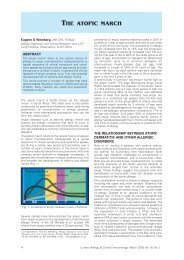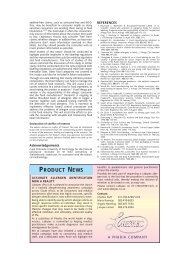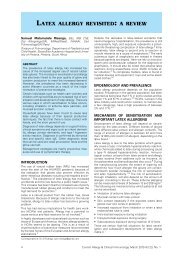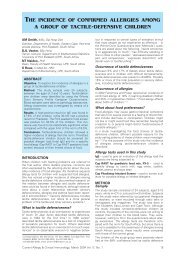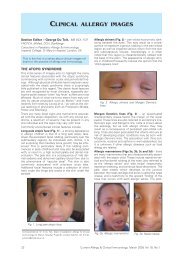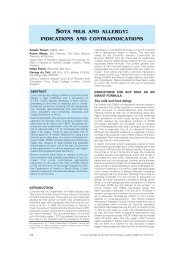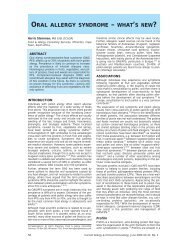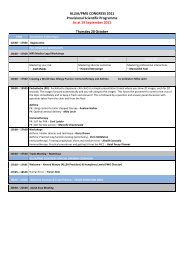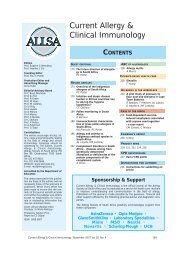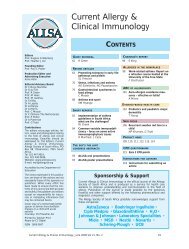Table II. Major uses of IVIGNeurologyHaematology<strong>Immunology</strong>DermatologyOtherGuillain BarresyndromeMultifocal motorneuropathyChronic inflammatorydemyelinatingpolyneuropathyDermatomyositis <strong>and</strong>inflammatorymyopathiesMyasthenia gravisLambert-EatonsyndromeStiff person syndromeImmunethrombocytopeniaPost bone marrowtransplantMyeloma <strong>and</strong>chroniclymphocyticleukaemiaParvovirusB19-associatedaplasiaImmuneneutropeniaImmune haemolyticanaemiaPrimary antibodydeficiencies(XLA, CVID, HIGMWAS <strong>and</strong> others)Secondary antibodydeficiencies(myeloma, CLL,drugs <strong>and</strong>other causes)KawasakisyndromeDermatomyositisToxic epidermalnecrolysisBlistering diseasesImmune urticariaAtopic dermatitisScleromyxoedemaPyodermagangrenosumVasculitisSysytemiclupuserythematosisStreptococcaltoxic shocksyndromeBirdshotretinochoroidopathyAutoimmuneuveitisMucousmembranepemphigoidIVIG is used mainly at high dose (2 g/kg) for the indications listed in neurology, haematology, rheumatology, dermatology <strong>and</strong> others while inimmunology replacement doses (0.4 g/kg) are given. XLA – X-linked agammaglobulinaemia, CVID – common variable immunodeficiency, HIGMimmunodeficiencywith hyper-IgM, WAS – Wiskott Aldrich syndrome, CLL – chronic lymphocytic leukaemia.Adapted from Jolles et al. 6therapy. A target trough level of a serum IgG equal tothe pretreatment level plus 300 mg/dl has been used.A dose must be individualised <strong>and</strong> titrated to achieveclinical effect for each patient. The issue of IgG dosefor patients with normal IgG levels but impaired specificantibody production is more difficult because IgGtrough levels are not particularly useful. Dose adjustmentswill be needed with children's growth or in protein-losingconditions. Despite the number of studiescomparing different IgG doses of primary immunodeficiency,none has directly compared different dosingintervals. At present the dosing interval should beselected according to the ability of a given regimen tomaintain an adequate IgG trough level, an acceptableclinical effect, or both. If patients who are receivingIVIG every 28 days experience malaise or upper respiratorytract symptoms in the week before infusion, amore frequent dosing schedule should be considered.Monitoring IVIG in primary antibodydeficienciesThe therapeutic guidelines for the monitoring of theuse of IVIG in primary antibody deficiencies are summarisedin Table III.Monitoring IVIG therapyIVIG therapy can take up to 6 months to achieve maximalbenefits. Trough levels increase gradually withoptimal dosing (400-600 mg/kg/month) until a steadystate is achieved after 4-8 months of regular IVIG infusions.Because of individual variation in IgG distribution<strong>and</strong> catabolism, serum IgG trough levels (i.e. prior toinfusion level) should be checked every 2 months forthe first 8 months of therapy to ensure that targettrough levels of > 500 mg/dl are met or exceeded.Once the dose has been optimised, trough levels needonly be monitored every 6 months. 11Monitoring liver functionLiver function including serum transaminase levelsshould be monitored regularly (every 3 months) toexclude subclinical, passively transmitted hepatitis.Batch numbers of the IVIG infused must be recorded inthe patient notes.Monitoring infectionsWhile patients are on IVIG therapy it is advised that thenumber, duration, site <strong>and</strong> severity of all infections, allantibiotic use <strong>and</strong> other relevant clinical details berecorded to document the benefit of the IVIG therapy.Monitoring disease progressionChest damage may progress insidiously despite optimalIVIG therapy so regular review of pulmonary functionis recommended.Autoimmune diseasesHigh dose IVIG has immunosuppressive <strong>and</strong> antiinflammatoryeffects <strong>and</strong> has been used with variableresults in several systemic autoimmune diseases(Table II). 6,7 In contrast to the 'replacement' dose of 400mg/kg/month, the 'high' dose IVIG is given at2 g/kg/month when it is used as an immunomodulatoryagent in immune or inflammatory disorders.Idiopathic thrombocytopenic purpura(ITP)ITP is an FDA-approved indication for IVIG. It is animportant treatment option of acute ITP in childrenwith the severe presentation (platelet count < 20 x10 9 /l) of this disorder. 8 It is used to treat patients atgreatest risk of bleeding complications or those withchronic refractory disease. The mechanism of action isthought to be blockade of the Fc receptors in the reticuloendothelialsystem leading to inhibition of binding<strong>and</strong> destruction of antibody-coated platelets.Haematological disordersIVIG has been used in numerous haematological conditions(Table II). 6,7Treatment for haemolytic disease of the newborn(HDN) includes phototherapy <strong>and</strong> exchange transfu-28 <strong>Current</strong> <strong>Allergy</strong> & <strong>Clinical</strong> <strong>Immunology</strong>, <strong>March</strong> <strong>2008</strong> Vol 21, No. 1
TABLE III. Recommendations for the use of IVIG in primary antibody immunodeficiencies1. Record br<strong>and</strong>, lot number, dose, infusion rate, <strong>and</strong> side reactions2. Maintain the IgG trough levels > 500 mg/dl3. IgG trough levels gradually increase for 4-8 months on high dose IVIG therapy4. For every 100 mg/kg of IVIG given, IgG peak levels increase 200-250 mg/dl <strong>and</strong> trough levels increase 100 ml/dl (after28 days)5. Usual maintenance dose is 400-500 mg/kg every 4 weeks6. Check IgG trough level every 2 months until stable, then every 6 months7. Check blood count <strong>and</strong> liver function tests twice yearly8. IgG half-life varies in different patients so dosage must be individualised9. Consider extra doses with infection, stress <strong>and</strong> gastrointestinal or genitourinary loss10. Home infusions, slow subcutaneous infusions <strong>and</strong> rapid infusion of 10-12% IVIG can be used for convenience, economy<strong>and</strong> shortened administration time in some patientsAdapted from Stiehm. 11sion. In the last few years IVIG has been shown to significantlyreduce the overall use of exchange transfusion.13,14 IVIG is recommended for the treatment ofHDN with severe hyperbilirubinaemia. The AmericanAcademy of Pediatrics (2004) 15 recommends IVIG treatment(0.5-1.0 g/kg over 2 hours) if the bilirubin is risingdespite intensive phototherapy or if it is within 2-3mg/dl (34-51 µmol/l) of the threshold for exchangetransfusion. 8,15 The mechanism of action is uncertainbut IVIG is thought to inhibit haemolysis by blockingantibody receptors on red blood cells.Neurological disordersIVIG is licensed for use in Guillain Barre syndrome(GBS) but is used in many other neurological conditions(Table II). 7,9,10,16 A Cochrane systematic review hasshown that IVIG is as efficacious as plasma exchangein GBS. 17 There are no r<strong>and</strong>omised trials of IVIG in childrenwith GBS but the evidence from the adult trialshas been sufficient for IVIG to be recommended in childrenwith GBS. IVIG (2 g/kg over 2-5 days for adults, 2days for children) is recommended as a treatment forGBS within 2 weeks of symptom onset for: (i) patientswith grade 3 symptoms (able to walk with aid) orgreater; or (ii) patients with symptoms that are progressing.ROUTE OF ADMINISTRATIONImmunoglobulin replacement therapy can be given viathe intramuscular, subcutaneous <strong>and</strong> intravenousroutes. Preparations intended for the intramuscular <strong>and</strong>subcutaneous routes must not be given intravenously.Intravenous administration pooled human immunoglobulinhas been available from 1981 <strong>and</strong> has becomean important therapy in clinical medicine. IVIG hasallowed infusion of higher doses over a short time, <strong>and</strong>has remained the st<strong>and</strong>ard route of administration.However IVIG therapy is not ideal for all patients. Thelimitations of IVIG are:• Difficulty for those with poor venous access• Patients with recurrent systemic reactions• Requires hospitalisation or a good home-care programme.Subcutaneous immunoglobulin (SCIg)Subcutaneous administration of immunoglobulin byslow infusion was tried in the late 1970s. 18 It was ab<strong>and</strong>onedbecause of the length of time of administration<strong>and</strong> the occurrence of sterile abscesses.However more recently reports have shown that rapidsubcutaneous immunoglobulin (SCIg) therapy is a safe,effective <strong>and</strong> well-tolerated alternative to IVIG. 19,20,21SCIg treatment does not require venous access <strong>and</strong> isassociated with the slow release of IgG into the bloodwhich enables trough IgG levels to remain high <strong>and</strong> stablebetween infusions. 22,23 The growing availability ofSCIg therapy for home administration has offeredincreased flexibility to both children <strong>and</strong> adults. 21,24There are no significant differences in efficacy oradverse reaction results between immunoglobulinreplacement therapy given subcutaneously <strong>and</strong> intravenously.21,25 There has been an increase in use of thesubcutaneous route in Europe. The immunoglobulindose used for subcutaneous replacement therapy isusually 0.1 g/kg/week.Subcutaneous infusions are only indicated in primaryimmunodeficiency disorders. It is unclear whether subcutaneousinfusions will be effective for disordersdepending on the immunomodulatory action of IVIG<strong>and</strong> it is not recommended for this use.SAFETY OF IVIGSystemic reactions to IVIG infusion range from 3% to15%. They are usually self-limiting <strong>and</strong> can be avoidedby decreasing the rate of the infusion. Infusion ratesare usually started at 0.01-0.02 ml/kg/min <strong>and</strong>increased up to 0.1 ml/kg/min. Fortunately most IVIGreactions are mild <strong>and</strong> non-anaphylactoid. Typically theyinclude backache, abdominal pain, nausea, chills, rhinitis,asthma, low-grade fever, myalgia <strong>and</strong> headaches(Table IV). Slowing or stopping the infusion for 15-30minutes will reverse many reactions. Pretreatment prophylaxiswith diphenhydramine (1 mg/kg/dose), acetaminophen(15 mg/kg/dose), aspirin (15 mg/kg/dose) oribuprofen (5 mg/kg/dose) is also helpful. More seriousreactions can be treated with hydrocortisone (6mg/kg/dose; maximum 100 mg). 11More serious adverse events can occur during or soonafter infusion: anaphylaxis, renal, cardiovascular, centralnervous system <strong>and</strong> haematological events havebeen reported. 26 Anaphylaxis is very rare <strong>and</strong> is associatedwith anti-IgA antibodies in some patients withtotal IgA deficiency (IgA < 0.05 g/l). Acute renal failure<strong>and</strong> neurodegeneration have been associated withIVIG but not temporally related to the infusion. 7 It hasbeen suggested that the sucrose-based products are<strong>Current</strong> <strong>Allergy</strong> & <strong>Clinical</strong> <strong>Immunology</strong>, <strong>March</strong> <strong>2008</strong> Vol 21, No. 1 29



